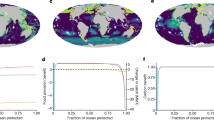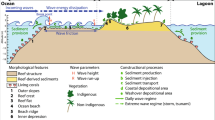Abstract
Ocean acidification is a global, long-term problem whose ultimate solution requires carbon dioxide reduction at a scope and scale that will take decades to accomplish successfully. Until that is achieved, feasible and locally relevant adaptation and mitigation measures are needed. To help to prioritize societal responses to ocean acidification, we present a spatially explicit, multidisciplinary vulnerability analysis of coastal human communities in the United States. We focus our analysis on shelled mollusc harvests, which are likely to be harmed by ocean acidification. Our results highlight US regions most vulnerable to ocean acidification (and why), important knowledge and information gaps, and opportunities to adapt through local actions. The research illustrates the benefits of integrating natural and social sciences to identify actions and other opportunities while policy, stakeholders and scientists are still in relatively early stages of developing research plans and responses to ocean acidification.
This is a preview of subscription content, access via your institution
Access options
Subscribe to this journal
Receive 12 print issues and online access
$209.00 per year
only $17.42 per issue
Buy this article
- Purchase on Springer Link
- Instant access to full article PDF
Prices may be subject to local taxes which are calculated during checkout



Similar content being viewed by others
References
IPCC. Climate Change 2014: Impacts, Adaptation, and Vulnerability Part B: Regional Aspects. (eds Field, C. B. et al.) (Cambridge Univ. Press, 2014).
Waldbusser, G. G., Voigt, E. P., Bergschneider, H., Green, M. A. & Newell, R. I. E. Long-term trends in Chesapeake Bay pH and effects on biocalcification in the Eastern Oyster Crassostrea virginica. Estuar. Coasts 34, 221–231 (2011).
Cai, W-J. et al. Acidification of subsurface coastal waters enhanced by eutrophication. Nature Geosci. 4, 766–770 (2011).
Feely, R. A., Sabine, C. L., Hernandez-Ayon, J. M., Ianson, D. & Hales, B. Evidence for upwelling of corrosive 'acidified' water onto the continental shelf. Science 320, 1490–1492 (2008).
Salisbury, J., Green, M., Hunt, C. W. & Campbell, J. Coastal acidification by rivers: a threat to shellfish? EOS Trans. Am. Geophys. Union 89, 513–528 (2008).
IPCC. Report of the IPCC Workshop on Impacts of Ocean Acidification on Marine Biology and Ecosystems, 164 (Carnegie Inst., 2011).
Duarte, C. M. et al. Is ocean acidification an open-ocean syndrome? Understanding anthropogenic impacts on seawater pH. Estuar. Coasts 36, 221–236 (2013).
Kelly, R. P. et al. Mitigating local causes of ocean acidification with existing laws. Science 332, 1036–1037 (2011).
Waldbusser, G. G. & Salisbury, J. E. Ocean acidification in the coastal zone from an organism's perspective: multiple system parameters, frequency domains, and habitats. Annu. Rev. Mar. Sci. 6, 221–247 (2014).
Gazeau, F. et al. Impacts of ocean acidification on marine shelled molluscs. Mar. Biol. 160, 2207–2245 (2013).
Parker, L. M. et al. Predicting the response of molluscs to the impact of ocean acidification. Biology 2, 651–692 (2013).
Kroeker, K. J. et al. Impacts of ocean acidification on marine organisms: quantifying sensitivities and interaction with warming. Glob. Change Biol. 19, 1884–1896 (2013).
Ocean Acidification: From Knowledge to Action. Washington State's Strategic Response. (Washington State Blue Ribbon Panel on Ocean Acidification, 2012); https://fortress.wa.gov/ecy/publications/publications/1201015.pdf
Cooley, S. R., Lucey, N., Kite-Powell, H. & Doney, S. C. Nutrition and income from molluscs today imply vulnerability to ocean acidification tomorrow. Fish Fisher. 13, 182–215 (2012).
Mathis, J. T. et al. Ocean acidification risk assessment for Alaska's fishery sector. Prog. Oceanogr. (in the press).
Hilmi, N. et al. Exposure of Mediterranean countries to ocean acidification. Water 6, 1719–1744 (2014).
National Estuary Research Reserve System; http://www.nerrs.noaa.gov/
Waldbusser, G. G. et al. A developmental and energetic basis linking larval oyster shell formation to ocean acidification. Geophys. Res. Lett. 40, 2171–2176 (2013).
Waldbusser, G. G. et al. Saturation-state sensitivity of marine bivalve larvae to ocean acidification. Nature Clim. Change http://dx.doi.org/10.1038/nclimate2479 (2014).
Barton, A., Hales, B., Waldbusser, G. G., Langdon, C. & Feely, R. A. The Pacific oyster, Crassostrea gigas, shows negative correlation to naturally elevated carbon dioxide levels: Implications for near-term ocean acidification effects. Limnol. Oceanogr. 57, 698–710 (2012).
Jepson, M. & Colburn, L. L. Development of Social Indicators of Fishing Community Vulnerability and Resilience in the US Southeast and Northeast Regions. NOAA Technical Memorandum NMFS-F/SPO-129 (US Dept Commerce, 2013).
Feely, R. A. et al. The combined effects of ocean acidification, mixing, and respiration on pH and carbonate saturation in an urbanized estuary. Estuar. Coast. Shelf Sci. 88, 442–449 (2010).
Gruber, N. et al. Rapid progression of ocean acidification in the California Current system. Science 337, 220–223 (2012).
Hauri, C. et al. Spatiotemporal variability and long-term trends of ocean acidification in the California Current system. Biogeosci. 10, 193–216 (2013).
Ocean Acidification Resolution: Establishing the Commission to Study the Effects of Ocean Acidification and its Potential Effects on Commercial Shellfish Harvested and Grown Along the Maine Coast (126th Maine Legislature, 2014); http://go.nature.com/tDN5Xh
Veneziano, S. in Boothbay Register (Maine, 2014).
van Hooidonk, R. J., Maynard, J. A., Manzello, D. & Planes, S. Opposite latitudinal gradients in projected ocean acidification and bleaching impacts on coral reefs. Glob. Change Biol. 103–112, (2014).
Bricker, S. et al. Effects of nutrient enrichment in the nation's estuaries: A decade of change. Harmful Algae 8, 21–32 (2008).
Zins, C. Conceptual approaches for defining data, information, and knowledge. J. Am. Soc. Inform. Sci. 58, 479–493 (2007).
Boisot, M. & Canals, A. Data, information and knowledge: Have we got it right? J. Evol. Econ. 14, 43–67 (2004).
Harris, K. E., DeGrandpre, M. D. & Hales, B. Aragonite saturation state dynamics in a coastal upwelling zone. Geophys. Res. Lett. 40, 1–6 (2013).
Doney, S. C. The growing human footprint on coastal and open-ocean syndrome? Understanding anthropogenic impacts on seawater pH. Science 328, 1512–1516 (2010).
Newton, J. A., Feely, R. A., Jewett, E. B., Williamson, P. & Mathis, J. T. Global Ocean Acidification Observing Network: Requirements and Governance Plan (Global Ocean Acidification Observing Network (GOA-ON), 2014).
Office of Science and Technology. NMFS Commercial Fisheries Statistics (2003–2012) (NOAA, 2014); http://go.nature.com/4HvsQG
Pespeni, M. H. et al. Evolutionary change during experimental ocean acidification. Proc. Natl Acad. Sci. USA 110, 6937–6942 (2013).
Sunday, J. M. et al. Evolution in an acidifying ocean. Trends Ecol. Evol. 29, 117–125 (2014).
Hofmann, G. E. et al. Exploring local adaptation and the ocean acidification seascape: studies in the California Current large marine ecosystem. Biogeosci. Discuss. 10, 11825–11856 (2013).
Adger, W. N. Social capital, collective action and adaptation to climate change. Econ. Geogr. 79, 387–404 (2003).
Wolf, J. Climate Change Adaptation as a Social Process Vol. 42 (Springer, 2011).
Moser, S. C. & Ekstrom, J. A. A framework to diagnose barriers to climate change adaptation. Proc. Natl Acad. Sci. USA 107, 22026–22031 (2010).
Moser, S. C. & Ekstrom, J. A. Identifying and Overcoming Barriers to Climate Change Adaptation in San Francisco Bay: Results from Case Studies. CEC-500-2012-034 (California Energy Commission, 2012).
Kahan, D. M. Fixing the communications failure. Nature 463, 296–297 (2010).
Maibach, E., Roser-Renouf, C. & Leiserowitz, A. Global Warming's Six Americas 2009: An Audience Segmentation Analysis (Yale Project on Climate Change, George Mason Univ. Center for Climate Change Communication, 2009).
Peters, R. G., Covello, V. T. & McCallum, D. B. The determinants of trust and credibility in environmental risk communication: an empirical study. Risk Anal. 17, 43–54 (1997).
Adger, W. N. et al. Are there social limits to adaptation to climate change? Clim. Change 93, 335–354 (2009).
Adger, W. N., Barnett, J., Brown, K., Marshall, N. & O'Brien, K. Cultural dimensions of climate change impacts and adaptation. Nature Clim. Change 3, 112–117 (2013).
Kelly, P. M. & Adger, W. N. Theory and practice in assessing vulnerability to climate change and facilitating adaptation. Clim. Change 47, 325–352 (2000).
Moser, S. C., Kasperson, R. E., Yohe, G. & Agyeman, J. Adaptation to climate change in the Northeast United States: opportunities, processes, constraints. Mitig. Adapt. Strateg. Glob. Change 13, 643–659 (2008).
Vogel, C., Moser, S. C., Kasperson, R. E. & Dabelko, G. D. Linking vulnerability, adaptation, and resilience science to practice: Pathways, players, and partnerships. Glob. Environ. Change 17, 349–364 (2007).
Dilling, L. & Lemos, M. C. Creating usable science: opportunities and constraints for climate knowledge and their implications for science policy. Glob. Environ. Change 21, 680–689 (2010).
Strategic Plan for Federal Research and Monitoring of Ocean Acidification (Interagency Working Group on Ocean Acidification, 2014); http://go.nature.com/3fr7Bq
Cutter, S. L., Boruff, B. J. & Shirley, W. L. Social vulnerability to environmental hazards. Social Sci. Q. 84, 242–261 (2003).
Marshall, N. et al. A framework for social adaptation to climate change: sustaining tropical coastal communities and industries, 36 (IUCN, 2010).
Cardona, O. et al. in IPCC Special Report of Working Groups I and II: Managing the Risks of Extreme Events and Disasters to Advance Climate Change Adaptation (eds Field, C. et al.) 65–108 (Cambridge Univ. Press, 2012).
Turner, B. L. I. et al. A framework for vulnerability analysis in sustainability science. Proc. Natl Acad. Sci. USA 100, 8074–8079 (2003).
Bricker, S. et al. Effects of Nutrient Enrichment in the Nation's Estuaries: A Decade of Change, 328 (National Centers for Coastal Ocean Science, 2007).
USGS National Water Information System (NWIS) Database (US Geological Survey, accessed April 2014); http://waterdata.usgs.gov/nwis
Hoekstra, J. M. et al. Upwelling Presence by Marine Province (Univ. California Press, 2010).
Acknowledgements
This work was supported by the National Socio-Environmental Synthesis Center (SESYNC) under funding received from the National Science Foundation DBI-1052875. Support for R.v.H. to generate model projections was provided by NOAA's Coral Reef Conservation Program. We thank the institutions and individuals that provided data (see Supplementary Information for full details), and W. McClintock and his laboratory for use of SeaSketch.org to enable collaborative discussions of spatial data and analysis. We are grateful for the contributions and advice provided by E. Jewett throughout the project.
Author information
Authors and Affiliations
Contributions
All authors provided input into data analysis and research design, and participated in at least one SESYNC workshop; J.A.E. led the drafting of the text with main contributions from L.S., S.R.C., L.H.P., G.G.W. and J.E.C.; R.v.H. contributed projections of ocean acidification; L.H.P. contributed shelled mollusc diversity scores; J.A.E., L.S., S.R.C., J.R., L.H.P. and C.D. collected the data; J.A.E. carried out data analysis and mapping.
Corresponding author
Ethics declarations
Competing interests
The authors declare no competing financial interests.
Supplementary information
Supplementary Information
Supplementary Information (PDF 2106 kb)
Rights and permissions
About this article
Cite this article
Ekstrom, J., Suatoni, L., Cooley, S. et al. Vulnerability and adaptation of US shellfisheries to ocean acidification. Nature Clim Change 5, 207–214 (2015). https://doi.org/10.1038/nclimate2508
Received:
Accepted:
Published:
Issue Date:
DOI: https://doi.org/10.1038/nclimate2508
This article is cited by
-
Ocean acidification in the Philippines and the potential role of water pollution management in mitigating an unaddressed threat
Regional Environmental Change (2023)
-
Impacts of ocean acidification on physiology and ecology of marine invertebrates: a comprehensive review
Aquatic Ecology (2023)
-
Upper environmental pCO2 drives sensitivity to ocean acidification in marine invertebrates
Nature Climate Change (2022)
-
Caribbean king crab larvae and juveniles show tolerance to ocean acidification and ocean warming
Marine Biology (2022)
-
Alkalinity cycling and carbonate chemistry decoupling in seagrass mystify processes of acidification mitigation
Scientific Reports (2021)



